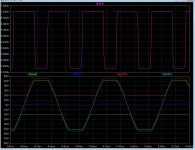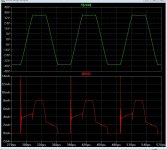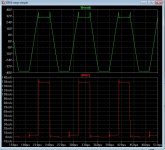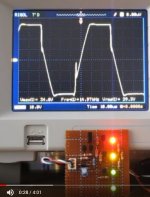Jan, I wouldn't say my tests were extensive though I would defend their rigor.Stocktrader, have you done similar extensive DBLT tests as Kgrlee? Your numbers seem different.
Besides, strictly speaking, we weren't comparing 0.1% THD with 0.01%THD but 2 amps, one of which had 0.1% just before overload and the other 0.01%.
It's very difficult to conduct DBlindLTs on a 10W amp as most other amps are much more powerful .. especially if you let the victim choose his own music and levels (which is one of the pillars of my DBLTs)
What I CAN say is that, of the amp tests on the competition, when a difference was reliably detected, we ALWAYS found the less liked one was a Golden Pinnae amp with wonky overload and/or instability on real speakers. This included several very famous names.
One thing which did come out of the JLH tests is that having a regulated PSU led to better sound. When an amp overloads, the PSU ripple is superimposed on the clipped signal which sounds really nasty on a Class A amp.
Out of that, we did formal DBLTs on a 50W developmental design of ours and found using a PSU toroid with the next lower voltage rating gave a small but reliable preference. With the same core, a lower transformer voltage allowed thicker wire and hence better regulation and less ripple on overload.
Transformer resistance has a MUCH greater effect on regulation & ripple than zillion uF caps in power amps.
Alas, Marketing insisted we use the higher voltage transformer cos it gave a higher measured output spec.
Last edited:
Hmmm. Overload, clipping, recovery..... Is this really a problem? How about, don't clip the amp in the first place?
10W? 50W? 200-250W + should take care of that issue for most conditions.
BTW - You have not heard full HD dynamic range playback until you hear the JBL M2 speaker system driven by its' 2500W/driver Crown PA's.
THx-RNMarsh
10W? 50W? 200-250W + should take care of that issue for most conditions.
BTW - You have not heard full HD dynamic range playback until you hear the JBL M2 speaker system driven by its' 2500W/driver Crown PA's.
THx-RNMarsh
Last edited:
Hi
Have to agree with Mr. Marsh about NOT clipping the amp.
I've used amps that were only a few watts when I had my first listening system, then later built some 15W JLHs and some Fairchild app-note amps that werre about 25W, and presently use amps that are about 15W biamped. I NEVER clipped any of these despite how loud I might have turned it up. The first amp was quite a POS mains-operated SE tube amp.
Our hearing is better at discerning details of sound at quiet sound pressures than at loud levels. The Fletcher-Munson curves clearly show how our aural compression is invoked more and more as SPL rises. The flatness of the 100dB curve does not show that our hearing is especially good at 100dB; rather, it shows how our hearing has become quite evenly bad over the whole frequency range. Aural compression protects our ears from loud sounds and is invoked by ALL sounds, much less so at human levels like 40db which is a conversational level.
I have to disagree with Mr. Marsh on the SPL we like to listen to music at. On other threads he has said to the effect that he likes to reproduce "live" levels at home. That is easy to do but it comes at the cost of eroding your hearing. I can't stay in the room if it is over 80dB and 90dB is just insane!
Having larger power amps to drive the speakers with everything well within their capabilities does produce an "effortless" sound, provided the amp does not have crossover distortion that would otherwise erode low-power performance.
Have to agree with Mr. Marsh about NOT clipping the amp.
I've used amps that were only a few watts when I had my first listening system, then later built some 15W JLHs and some Fairchild app-note amps that werre about 25W, and presently use amps that are about 15W biamped. I NEVER clipped any of these despite how loud I might have turned it up. The first amp was quite a POS mains-operated SE tube amp.
Our hearing is better at discerning details of sound at quiet sound pressures than at loud levels. The Fletcher-Munson curves clearly show how our aural compression is invoked more and more as SPL rises. The flatness of the 100dB curve does not show that our hearing is especially good at 100dB; rather, it shows how our hearing has become quite evenly bad over the whole frequency range. Aural compression protects our ears from loud sounds and is invoked by ALL sounds, much less so at human levels like 40db which is a conversational level.
I have to disagree with Mr. Marsh on the SPL we like to listen to music at. On other threads he has said to the effect that he likes to reproduce "live" levels at home. That is easy to do but it comes at the cost of eroding your hearing. I can't stay in the room if it is over 80dB and 90dB is just insane!
Having larger power amps to drive the speakers with everything well within their capabilities does produce an "effortless" sound, provided the amp does not have crossover distortion that would otherwise erode low-power performance.
But people DO clip their amps. Best to design with that in mind. Also consider the stress of components when in saturation. Self's "blameless" is among the worst , needs a anti-saturation diode and resistance at the beta enhancement tranny. Still gets hotter at overload. Symmetrical stages are easier to tame , some even clamp saturation. Driving a hungry Subwoofer , this is preferred by me.
Accidents can also happen , too high a input level / or feedback. A amp that is anti saturation might do better and survive.
Below 1 is native clamping , 2/3 is a "blameless" with and without "the fix". Even with "the fix" , the blameless loses phase margin and momentarily oscillates as it recovers from saturation. Not good for tweeters or transistors.
OS
Accidents can also happen , too high a input level / or feedback. A amp that is anti saturation might do better and survive.
Below 1 is native clamping , 2/3 is a "blameless" with and without "the fix". Even with "the fix" , the blameless loses phase margin and momentarily oscillates as it recovers from saturation. Not good for tweeters or transistors.
OS
Attachments
BTW - You have not heard full HD dynamic range playback until you hear the JBL M2 speaker system driven by its' 2500W/driver Crown PA's.
THx-RNMarsh
Ahh , the Crowns - Glorious Class G /H .
Yummy power !!
OS
Hi all, I have experience in the field of brand amp repairs. People.... Please...... Buy a decent amp for your speakers...... Some believe to protect your speakers you need to buy an amp abit lower wattage than your speakers, some again believe that a higher wattage amp than speaker wattage........ Well I believe if your amp is higher than 1000 Watts and plus it needs a limiter. Ha ha ha ha ha if you can't set the limiter pay a professional��. By the way Self book is a good book in the sense of theory and real world builds.
When I played my own recordings of eg singers or piano, I often clipped a 1000W amp on 90dB/W@1m speakers.How about, don't clip the amp in the first place?
My optimum domestic amp would be 200W 8R - 400W 4R .. not cos I won't clip it .. but cos if well designed, the clipping is usually un-noticed. I don't have the space or $$$ for the 1kW amp.
If you are using a 50W amp at home, you will be clipping it MUCH more often than you realise.
Of course if you play only modern 'music' (??) with 3dB Dynamic Range, you can get away with less... though you will probably clip it at parties when everyone has had a few
There used to be a Poll/Survey/Test (IIRC, on this forum) which would determine how much power YOU need, playing YOUR music, at YOUR favoured levels. Anyone know what's happened to it?
ostripper, that's exactly what I find with plain 'Blameless' in real life. Can you show circuits of your 'fixed' and 'unfixed' amps from which you did those simulation?
Last edited:
In terms of clipping always worth re-reading this CordellAudio.com - Home Entertainment Show 2007
Of course the joy of an all digital chain is that you know what 0dBFS is and so can set things up so they don't clip. They just might not get as loud as your want
@Kgrlee: Glad to see you resurface. I need to email you to ask some questions on something.
Of course the joy of an all digital chain is that you know what 0dBFS is and so can set things up so they don't clip. They just might not get as loud as your want
@Kgrlee: Glad to see you resurface. I need to email you to ask some questions on something.
Thanks for digging this up Bill.In terms of clipping always worth re-reading this CordellAudio.com - Home Entertainment Show 2007.
Alas, Bob Cordell tells us that re-issues of 'Flying Cowboys' have nothing like the Dynamic Range of the original pressing.
Should point out that overload affects music differently.
In my experience, piano is very sensitive (for other stuff like dither too) and also small (12-20) unaccompanied groups of singers.
Singers can sing in-tune or IN-TUNE. Very good singers can be so close in pitch that you have instances where 2 of them combine 6dB instantaneously instead of 3dB. Recording such a group often has your Peak meters jumping all over the place and I sometimes hear intermodulation within my ears when singing in such a group.
More than 20 and the chorus effect takes precedence and the peak levels sorta obey 3dB for every doubling of forces.
Then there's stuff where clipping is inaudible. Clap sticks, rim shots and applause really can't be recorded without overload except at ridiculously low record settings .. but don't usually sound any worse for being clipped.
Bill, I've returned to civilisation after an extended period of serious beach bum existence. I'm not quite back in civilised form yet. eg I've lost all my facility with LTspice.
in audiophile words: if it clips it is too late! d.self imho has the same opinion. when it clips it should be as inaudible as possible. but it isn't. when it clips, then we have mostly lfe effects and/or heavy bass. we aleays hear it. no ultra tube amp can repair this. but if the amp is fast and good designed, clipping doesn't kill our expensive beryllium treble speakers...
in my 13.4 (17) speakers powered home cinema i try to stay below clipping. with 17 * 200w@8r i'm save so far.
br, toni
in my 13.4 (17) speakers powered home cinema i try to stay below clipping. with 17 * 200w@8r i'm save so far.
br, toni
Last edited:
Design and build a Neg-Clip detector circuit and a Pos-Clip detector circuit for each channel, and have them drive BRIGHT indicator lamps. Perhaps include a 500 msec pulse-stretcher just to make it distressingly obvious when clipping has occurred. Ya can't miss that!
Now you don't need to accept the claims (without proof or evidence) from random online strangers, about how often clipping does or does not occur. Observe it yourself, directly!
Self APAD 6th edition shows the bare bones beginning of such a design in Fig 24.33
Now you don't need to accept the claims (without proof or evidence) from random online strangers, about how often clipping does or does not occur. Observe it yourself, directly!
Self APAD 6th edition shows the bare bones beginning of such a design in Fig 24.33
Rod Elliot has a simple ...Design and build a Neg-Clip detector circuit and a Pos-Clip detector circuit for each channel, and have them drive BRIGHT indicator lamps. Perhaps include a 500 msec pulse-stretcher just to make it distressingly obvious when clipping has occurred.
Self APAD 6th edition shows the bare bones beginning of such a design in Fig 24.33
Sound Impairment Monitor (SIM) - Is This The Answer?
... and I've lived for long periods with similar devices (and also those working on diffferent priniciples) since the early 70s .. when I first stated playing seriously with power amps. You do need to stretch the clipping indicator signal to at least 1sec to be useful in a domestic setting.
Was Self's clipping monitor in his earlier editions? IIRC, its not in the 4th edition.
But in da evil digital age, you can work out YOUR exact power requirements by even simpler mieans.
Anyone know what's happened to the Poll/Survey/Test, IIRC on this forum?
astx, if I ever build my 200W 8R domestic amp, it will be based on your designs
Last edited:
What a badly designed audio power amplifier in the video of post #34. It is ill-behaved during clipping and creates tweeter-killing ultra high frequency spikes on the output. Ugh.
_
APEX amplifier clip
YouTube
The clipping recovery/behaviour doesn't make a lot of difference to whether your tweeter will be damaged. The damage is done by the large amount and high level of high harmonics that are created by the clipping itself.
Of course if the clipping hangs in there for ages, it is made worse, but even when it recovers nicely and quickly, the damage may already have been done.
The amp shown in the video linked to above clips very nicely and cleanly, as well as it can be. Recovers well, no hangover. There are some onsets of oscillations seen which he fixes by apparently playing with the compensation, but the clipping is exemplary. The one in post # 34 is horrible, by comparison. Of course this is only at 1kHz - the real deal is what happens at 10kHz ;-)
I do remember Bob Cordell demo-ing a 40W tube amp versus a 200W solid state at a Rocky Mountain Audio Fest many years ago. At reasonably low playing levels, nobody heard a difference, but when he turned it up and the tube amp started clipping, it was clear which was which.
So, clearly, power does matter ;-)
Jan
Of course if the clipping hangs in there for ages, it is made worse, but even when it recovers nicely and quickly, the damage may already have been done.
The amp shown in the video linked to above clips very nicely and cleanly, as well as it can be. Recovers well, no hangover. There are some onsets of oscillations seen which he fixes by apparently playing with the compensation, but the clipping is exemplary. The one in post # 34 is horrible, by comparison. Of course this is only at 1kHz - the real deal is what happens at 10kHz ;-)
I do remember Bob Cordell demo-ing a 40W tube amp versus a 200W solid state at a Rocky Mountain Audio Fest many years ago. At reasonably low playing levels, nobody heard a difference, but when he turned it up and the tube amp started clipping, it was clear which was which.
So, clearly, power does matter ;-)
Jan
Last edited:
Many thanks! I will reserve some pcb's for you!...
astx, if I ever build my 200W 8R domestic amp, it will be based on your designs
Have fun, Toni
...
So, clearly, power does matter ;-)
...

- Status
- This old topic is closed. If you want to reopen this topic, contact a moderator using the "Report Post" button.
- Home
- Amplifiers
- Solid State
- Audio Power Amplifier by Douglas Self



